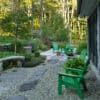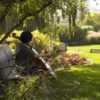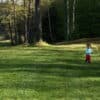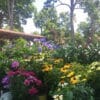After blasting through Tijuana and Ensenada, the subsequent agricultural vastness of the likes of Driscoll’s, and the surf meccas of the SoCal dudes, the Baja landscape emerges primordial, raw, undeveloped, disconnected, and the perfect place for a 2,500 mile holiday roadtrip.

Cardón Cacti line the roadsides. Photo: Anna Johansen.
The singular cardón cactus (close relative of the saguaro) became forests and the recent volcanic geologic past proudly displayed piles of boulders on top of ancient seabeds. Though it was the dry season in December, roadside pit stops were full of botanical wonders. Often spiny and sharp as the ground and mountains they grew out of, it was no wonder this penisula is thought of the last great frontier.

Towering Boojums reach towards the sky. Photos: L: Chris Bowlen; R: Anna Johansen.
A relatively brief (4 hours or so) interlude from the meaty cardóns, we encountered a land hairy with a plant that conceivably inspired Dr. Seuss. Like carrots inverted in the sand, the
bizarre Boojums can reach heights of 60 feet, sometimes relentlessly split‐ending or turning back to the ground in a giant hoop. They are endemic to the peninsula and were apparently named after the Lewis Carroll poem “The Hunting of the Snark” which “with infinite humor the impossible voyage of an improbable crew to find an inconceivable creature” (worthy of a
wikipedia detour).

L: A makeshift roadside solar array; R: A tumbleweed snowman spreads holiday cheer. Photos: L: Marta Johansen; R: Chris Bowlen.
The people are resourceful as one would need to be in such an environment. Solar arrays, palm frond brooms, tin can Christmas ornaments, and a tumbleweed “snowman” were just a few examples.

L: A view of Coyote Island from the volcanic shore; R: Kayaking in the Sea of Cortez.
Photos: L: Marta Johansen; R: Chris Bowlen.
Crossing the penninsula in a zig zag is the only sane way down. The Sea of Cortez divides mainland Mexico from Baja and is the destination for kayakers, snorkelers, RV’s and the like.

The view from our bungalow. Photo: Anna Johansen.
We finally arrived at our Christmas destination–the quiet surfer, artsy, friendly Todos Santos.

One of the many building facades going back to nature. Photo: Anna Johansen.
Leaving town (sadly) we stopped in one of the oldest villages in Baja, Triunfo. Although quiet and rundown, nature’s way of taking over brick by brick was wildly beautiful. Oddly
enough, this little gem is said to have the best bakery in all of Baja, which by noon was cleaned out.

L: A vulture warms its winds; R: The San Javier Mission. Photos: L: Anna Johansen; R: Chris Bowlen.
Climbing the infinite rubble strewn road to the 17th century village of San Javier, flocks of vultures warmed their wings on top of cacti and affirmed our relief of having an extra tank of gas in the trunk. Cave paintings and citrus orchards made the 20 mile (but 1.5 hour) detour to the mission of San Javier that much more rewarding.

L: The Adobe Guadalupe Vineyard, complete with inner courtyards with fountains, orange trees, rosemary, and lavender hedges; R: on horseback through the olive groves. Photos: Chris Bowlen.
Our final major stop was back in the North of Baja, the Valley of Guadalupe. Wine is the main attraction but I was even more taken by the horseride through the olive groves and citrus orchards, albeit for a wine tasting.






I love the tumbleweed snowman! Beautiful pictures.
Anna,
You and Chris did a great job on the pictures! And nice story to go with them. Who knew there was so much to do in Baja and that they have wineries, too.